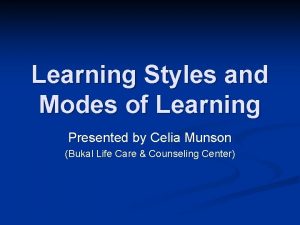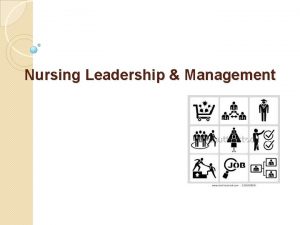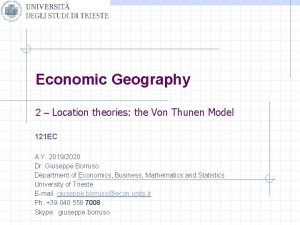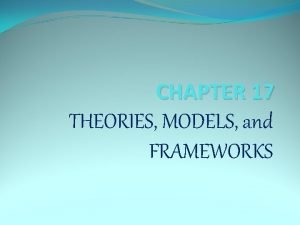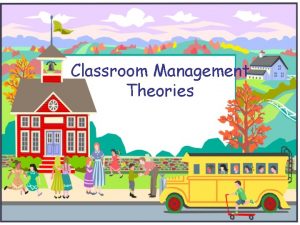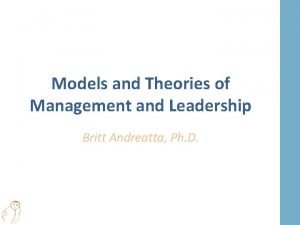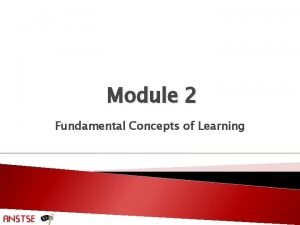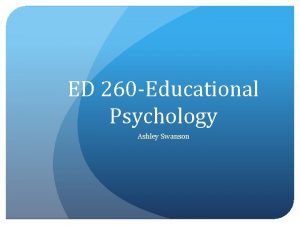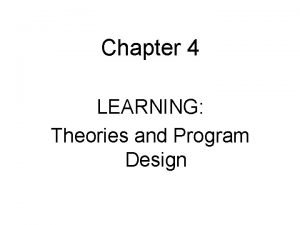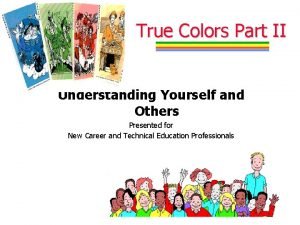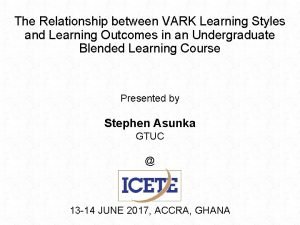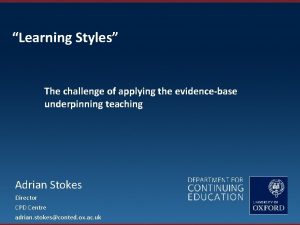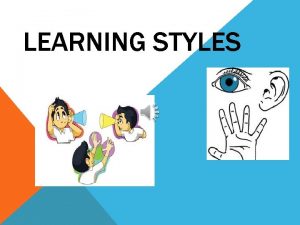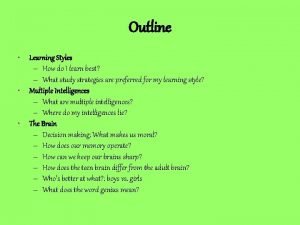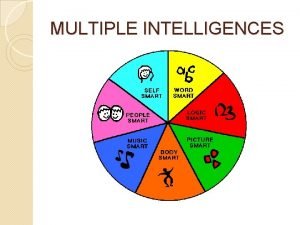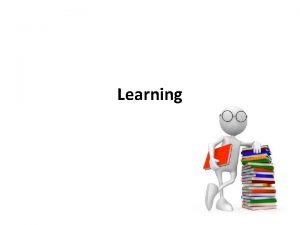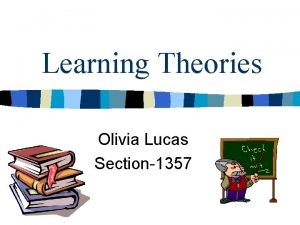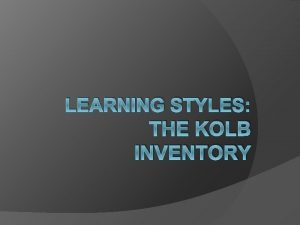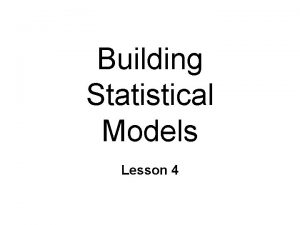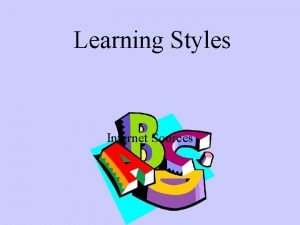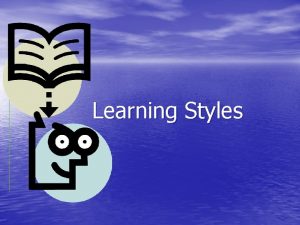Learning Styles An Overview of theories models and



















- Slides: 19

Learning Styles An Overview of theories, models and measures Manuel Papagolos March 13’ 2006 Introduction Research in the area of learning style is being conducted in domains outside psychology – the discipline from which many of the central concepts and theories originate. This includes medical and health care training, management, industry, vocational training and a vast range of settings and levels in the field of education.

There a number of learning-related concepts which have been the focus of attention when attempting to identify factors affecting learning-related performance: n n n Perception of academic control Achievement Motivation Learning Style

Learning Style n There is general acceptance that the manner in which individuals choose to approach a learning situation has an impact of performance and achievement

Key Terminology n n n Cognitive Style – an individual’s typical or habitual mode of problem solving, thinking, perceiving and remembering Learning Style – a concern with the application of cognitive style in a learning situation – can change over time or can be stable Preferences – favoring one method of teaching over another, as learning preferences

Curry’s Onion Model n Curry used this model to propose a “layer-like” model of learning behavior – using an onion metaphor to illustrate the inner and outer layers.

Curry’s “layers” n n Instructional Preference – an individual’s preferred choice of learning environment Social Interaction – relates to an individual’s preference for social interaction during learning Information processing – an individual’s intellectual approach to the processing of information Cognitive personality style – a relatively permanent personality dimension – when an individual’s behavior is observed across many different learning situations

Riding and Cheema’s Fundamental Dimensions n Having identified in excess of 30 labels used to describe a variety of cognitive and learning styles, Riding and Cheema propose a broad categorization of style according to two fundamental dimensions representing the way in which information is processed and represented: who list-analytic and verbalizerimager

Riding and Cheema n n Who list-analytic dimension – represents the manner in which individuals tend to process information either as a whole, or broken down in parts Verbalizer-imager – describes the degree to which individuals tend to represent information as words or images

Riding and Cheema n Conclusion – while there is relatively little research comparing the various styles, they can at least be placed into the two broad categories of who list-analytic and verbal-imagery, in order to simplify. The two styles exist independently and are not contingent upon one another

Cognitive-Centered, Activity-Centered and Personality-Centered Approaches n n n Cognitive-centered approach – focus us on the identification of styles based on individual difference in cognitive and perceptual functioning Learning-centered approach – distinguished on the basis that there is a greater interest in the impact of style on learning in an educational setting Personality –centered – only a limited amount of info – only a single model incorporates as a major factor

Theories Models and Measures n I have included a sampling of models and a discussion of their models, measurement and comments. These are not allinclusive as there have been many, many studies involving these theories.

Theories, Models and Measures n n Witkin’s Field-Dependence/Field Independence Model – Field dependence is an individual’s ability to dissembled in perceptual tasks – associated with learning in isolation as opposed to integration. Field independent learners rely more on an external frame of reference, very motivated, respond better to clearly defined performance goals, need structure and guidance, and interaction

Witkin’s Field-Dependence Field Independence n n Measurement – Embedded Figures Test (EFT) have been used to measure the construct Comments – This theory has been criticized based on the following grounds: to generalize performance on perceptual tasks to personality ad social behavior is an overextension of theory

Kagan’s Impulsivity. Reflexivity Who list-Analytic Style Family/Cognitive-Centered Approach/Cognitive Personality Style n n Model and measurement – using the Matching Familiar Figures Test (MFFT) which requires familiar line drawing of objects to be matched against several possibilities. A quick response would indicate “cognitive impulsive” while those who scrutinize would be labeled “cognitive reflective” Comments – Good – significant correlations between MFFT and EFT scores

Convergent-Divergent Styles (Wholist-Analytic Style Family/Cognitive-Centered Approach/Cognitive Personality Style n Model – Convergent style is characterized by the generation of the one accepted correct answer from the available information and divergent style as a propensity to produce a number of potentially acceptable solutions to the problem

Convergent-Divergent Styles (Who list-Analytic Style Family/Cognitive-Centered Approach/Cognitive Personality Style) (cont’d) n n Measurement – Convergent uses standard intelligence tests, multiple-choice items, as well as the EFT and MFFT. Divergent uses tests such as Uses of Objects Test and the Consequences Test as potentially correct answers is used as an index Comments – needs to be a like-for-like match between teacher and student in preferred style

Holzman and Klein’s Leveller-Sharpener Styles (Who list-Analytic Style Family/Cognitive-Centered Approach/Cognitive Personality Style) n n n Model – The leveler has the tendency to oversimplify their perceptions of the task and reducing complexity. The sharpener fails to assimilate effectively, but introduces complexity, treating each detail or event as a novel. Measurement – Schematizing test – required individuals to judge the size of squares of light which get progressively bigger. Comments – has shown some similarities to fielddependence/independence

Manuel Papagolos March 13, 2006 Learning Styles in Action n n Academic Achievement – positively correlated with a strategic approach, negatively correlated with an apathetic approach and unrelated to a deep approach to learning. Clinical training in medical schools – students learning styles, NOT their final exam results, were related to the amount of knowledge gained Career Development – learning styles key factor in “high flyer” development Police Training – done with little regard for individual difference in learning

Working with Learning Style n n Curry – highlights the failure to identify and agree upon style characteristics most relevant to learners and instructional settings as a major concern You need to assess the objective of a learning situation and match the appropriate model of learning style to it in order to be effective Ref: Educational Psychology, Vol. 24, No. 4, August 2004. Learning Styles: An overview of theories, models, and measures. Simon Cassidy.
 Learning styles models
Learning styles models Nursing leadership theories and styles
Nursing leadership theories and styles Chapter 7 motivation concepts
Chapter 7 motivation concepts Industrial location theories and models
Industrial location theories and models Nursing informatics theories, models and frameworks
Nursing informatics theories, models and frameworks Demographic transition model ap human geography definition
Demographic transition model ap human geography definition Classroom management models and theories
Classroom management models and theories Management models and theories
Management models and theories What is the difference between model and semi modal
What is the difference between model and semi modal 7 learning styles and vark similarities
7 learning styles and vark similarities Thpes of learning
Thpes of learning Multiple intelligences and learning styles
Multiple intelligences and learning styles Learning theories and program design
Learning theories and program design Cuadro comparativo e-learning y b-learning
Cuadro comparativo e-learning y b-learning Gold blue green orange personality test
Gold blue green orange personality test Vark inventory
Vark inventory Http://www.educationplanner.org
Http://www.educationplanner.org Objectives of learning styles
Objectives of learning styles Learning style outline
Learning style outline 8 learning styles gardner
8 learning styles gardner
